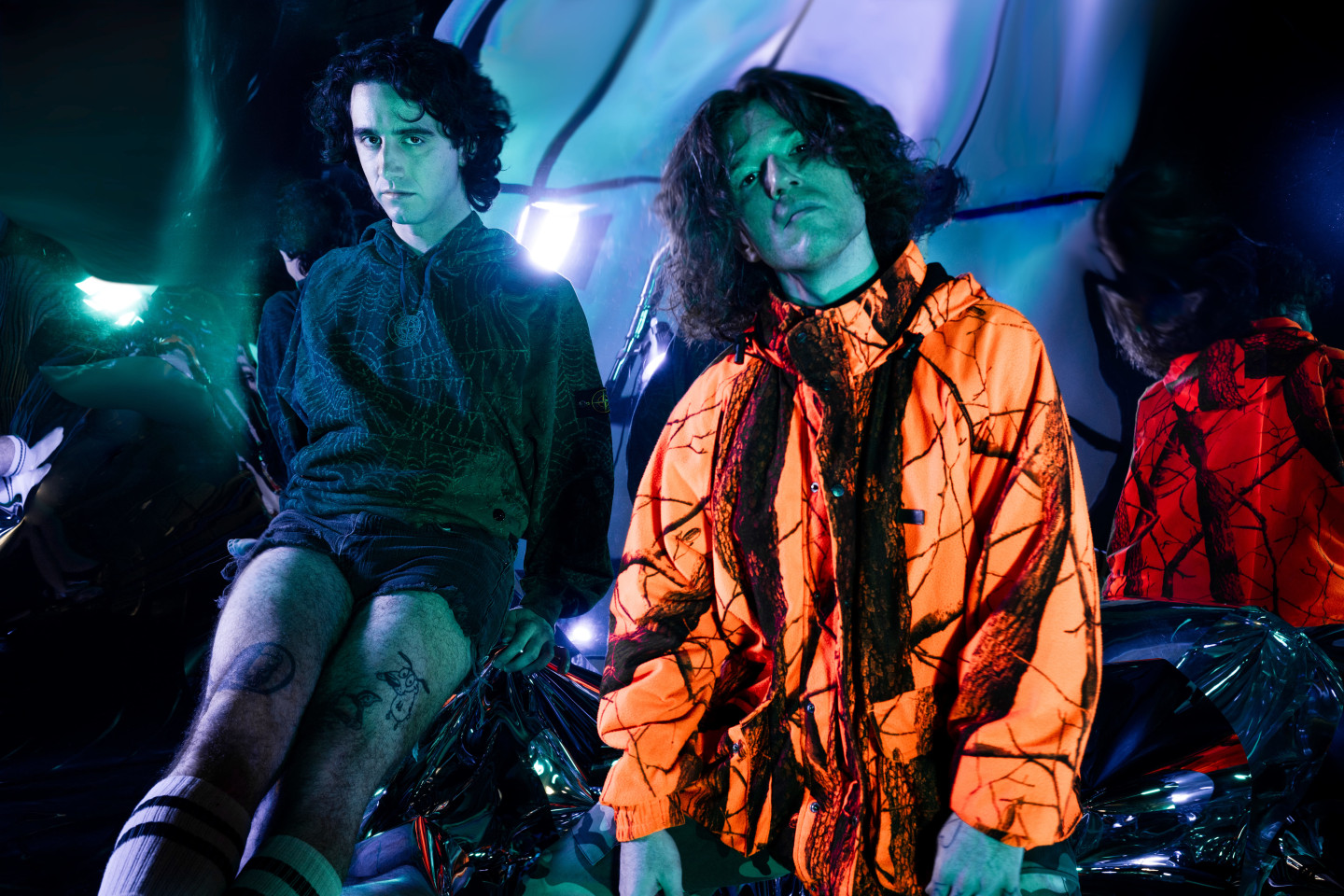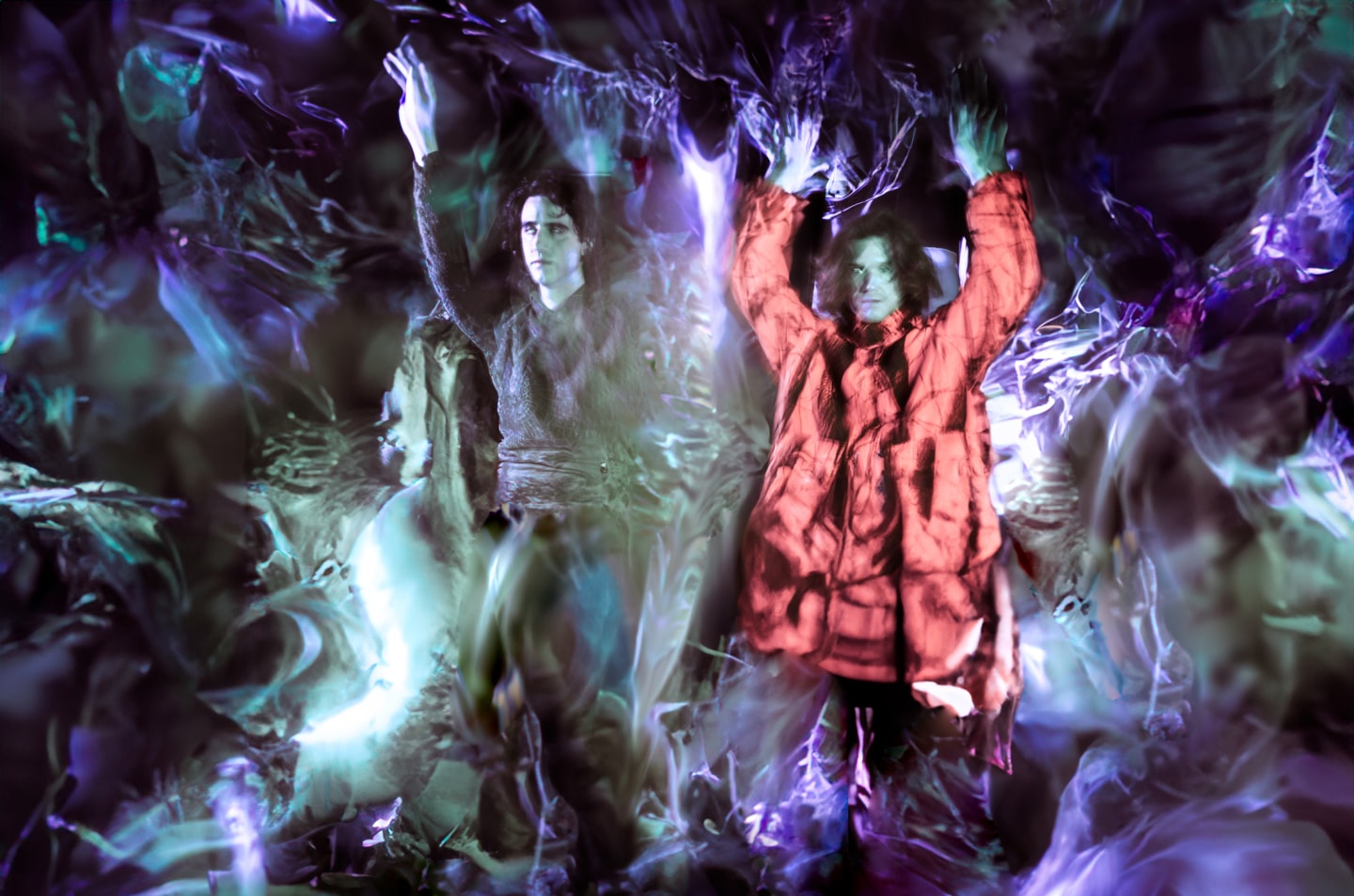 Machine Girl. Photo by Signe Pierce and Molly O’Brien.
Machine Girl. Photo by Signe Pierce and Molly O’Brien.
“Obsession is a strong word,” says Matt Stephenson, Machine Girl’s founder and creative force. He prefers “fixation” as a descriptor for the way he’s steered his post-industrial, post-hardcore, post-post-post-modern band these past 12 years. We’re discussing this storied run over quarter-chicken combos at Super Pollo Restaurant in Ridgewood, Queens. It was this meal, he says, ordered countless times with very little variation, that fueled the recording of the group’s new album, MG Ultra. It’s far from the first fix he’s had in heavy rotation.
For instance, the concept for MG’s debut album, Wlfgrl, came from Stephenson’s fixation on werewolves, born from a fixation on the 2000 camp-horror movie Ginger Snaps. Its cover art features an original prop from a different film, the 1981 cult classic An American Werewolf in London. Following another fixation, he named his creative project Machine Girl in honor of a 2008 Japanese horror-action comedy.
Stephenson brought on analog/digital drummer and fellow fixator Sean Kelly in 2015, making Machine Girl a duo. He’s here with us, too, quarter-chicken combo on his placemat. “I’m still obsessed with any genre of music with psychopathic percussion,” he says, claiming he listens to hours of the stuff almost daily.
Both Long Island natives, Kelly and Stephenson first bonded over these wild rhythms as teens, finding common ground in the left-field dance music of Aphex Twin and DJ Rashad — “The first traction I got was from a footwork community on Facebook,” Stephenson says — and the industrial freak rap of Death Grips. They also shared a stubborn streak in support of heavy nerd rockers like Primus and Mr. Bungle, and the decreasingly cool nu-metal acts they’d grown up on: Slipknot and System of a Down, of course, but also artists who still haven’t received their popular Renaissance. “We liked Incubus… a lot,” Kelly says. “The first Incubus LP has the first jungle/drum-and-bass that I heard as a teenager. They let the DJ go crazy on some outro or hidden track, and I showed Matt. I wasn’t like, ‘This is drum and bass!’ I was like, ‘This is Incubus. Check this out.’”
Over the past decade, the duo’s interests have grown more esoteric: Jungian psychology, Jodorowskian psychomagic, and tarot, to name a few. The fixation shoe still fits, though. On MG Ultra, Stephenson and Kelly pay gleeful, horrifying homage to the most obsessive obsession of them all: the conspiracy theory.
“MG Ultra” is a double entendre: The obvious connection to MKUltra (the CIA’s infamous mid-century human experimentation program) is set against the idea that Machine Girl’s new LP finds the duo in their final form. Per a press release, the album is a “manic collision between the different genres explored in previous MG releases [at] their most distilled.”
The first part of the pun is a bit of a red herring; no songs on the record specifically reference MKUltra, the Zapruder film, or PizzaGate. Conspiracy is more of a meta motif on MG Ultra than a central theme. Throughout the record, Stephenson seems more interested in exploring the conditions which create a society that comforts itself with dreams of reptoid, adrenochrome-harvesting elites and unidentified aerial phenomena. Early-album track “Sick!!!” explores the state of paranoia produced by brainrot-inducing, hours-long doomscroll sessions, while “Schizodipshit” describes the type of person who proudly flaunts their fact-resistant philosophies, unrepentant of their negative effects on friends, family, and the world at large. “Maybe I’m a little sick / But I’m not a victim,” Stephenson shouts near the end of the song. “All–American prick / So shut up and listen.”
Stephenson and Kelly like to indulge in conspiratorial thinking as much as the next meme-fed late millennials, but it’s not a particularly strong fixation, they tell me. Their most firmly held conspiracy theory is that many popular memes — the “Damn, Daniel” craze and the crazy clown hysteria of 2016, for instance — are CIA PSYOPs. They don’t believe aliens exist on Earth, but they do think the seeds of our collective ET-mania were propagated by the military-industrial complex to distract the sci-fi-obsessed public from the U.S. Army’s countless crimes against humanity.
“That’s what I miss about Facebook groups: You could find a crazy artist and see their real name and their mom. Maybe that’s a little fucked up, but you used to be able to get to know the person.”
The press release is more on point with the second half of its “MG Ultra” conceit; the album is the clearest distillation of the Machine Girl aesthetic to date. This is due in large part to Stephenson’s hyper-precise production, tightly stacked and cleanly spliced in the split-second switch-ups — from breakcore to digicore to hardcore chaos — that have always been crucial components of his best tracks. (Unsurprisingly, Stephenson thinks subgeneric “core” significations are silly and suggests I refer to MG’s style as “post-core.”)
These exquisitely executed pivots could only come from a particularly obsessive strain of perfectionism. “We’ll play [the tracks] over and over and dig into every detail, flip over every stone,” Kelly says. “Matt shows up with a 95%-finished song, but the last bit is super daunting.” It’s worth noting that Kelly was more involved in this album’s production process than he had been on any past recording. On previous releases like U-Void Synthesizer and The Ugly Art, Stephenson says he “would just put drum [tracks] in and say, ‘Do this.’ But this time, I’d take everything out and give Sean a project without drums in it, like, ‘Do whatever works.’” This change fostered an environment where Sean could write organically “from a drummer’s perspective,” both artists say. One might imagine such a method producing a dissonance between the percussion and the rest of the music, but the sounds here are even more synched up than on past projects.
The resulting album is packed with moments of anthemic ecstasy. Opener “Until I Die” is essentially a Machine Girl fight song; “Motherfather” is a hype track for anyone who yearns to rebel against an oppressive force, be it parental, systematic, or celestial. Even the less thematically anthemic tracks hit insanely hard: “Nu Nu Meta Phenomena” fuses footwork polyrhythms, house synths, and frenetic bass, and “Grindhouse” could convincingly replace The Pump Panel’s edit of New Order’s “Confusion” to soundtrack the blood rave from Blade. These are club bangers for the generations who came of age after Y2K, tracks that fuel the late-capitalist compulsion to dance out of one’s own skin before the apocalypse.
What’s lost in the industrial crackle of earlier MG albums is more than made up for in the pop with which MG Ultra’s songs snap into place. After nine years of creative partnership, MG’s mind meld is finally complete; the machine is operating at maximum efficiency.
“It’s the machine rebelling against the machine.”
If Machine Girl’s creative process is defined by fixation, their fanbase is obsessed to the point of rabidity. This phenomenon is evident at their packed-out shows but even more so online, where a community of self-dubbed “mutants” has sprouted organically around their synthesized roots.
While overwhelmingly pure of heart, the MG fan club has veered at times toward the far right. “There was a Machine Girl Discord run by a bunch of 4chan trolls,” Stephenson says. “I didn’t want that to be what represented us, so I created an official Discord in 2020 and went into the unofficial one and told them all to fuck off.”
The official Discord has since ballooned exponentially. At time of writing, there are 1,843 members online, and there have been roughly 500 messages sent across its 30-odd channels in the past three hours. (There’s a “SPAWN POINT” for general discussion; a “FOURTH WALL” for (limited) band/fan interaction; and dedicated channels for #gaymers-anonymous, #selfie🤳fitpic🤳zone, #movie-enjoyers, and more.)
“It’s great to see [the fans] interact with each other,” Kelly says. “They’re all artists too, and they get connected; small scenes have been forming.” Still, it’s no substitute for the IRL connections he and Stephenson have made with fans and peers alike during their time in New York (where they’re currently based), Pittsburgh — where they lived between 2018 and 2020 — and on the road.
“People really dug their feet in; people we’ve played shows with for 10 years are still here and playing,” Kelly says. “On Discord, it’s thousands of people coming and going, and they all have superhero names. That’s what I miss about Facebook groups: You could find a crazy artist and see their real name and their mom. Maybe that’s a little fucked up, but you used to be able to get to know the person. Discord is like Facebook on steroids. It’s overwhelming.”
 Photo by Signe Pierce and Molly O’Brien.
Photo by Signe Pierce and Molly O’Brien.
Several weeks after our interview and two days before MG Ultra’s release, Machine Girl fans and affiliates filter into Topos Too, a Ridgewood bookstore/café/bar. They’re here for the album’s official listening party, which will be accompanied by a silent screening of the 1990 Martian sci-fi blockbuster Total Recall — one of the most expensive films ever made at the time of its release, Stephenson informs me on a stroll around the block. (MG Ultra cut “Ass2Mars” pays tribute to the film’s interplanetary theme.)
The Topos Too event feels more like a gathering of friends than a Machine Girl convention, though there are plenty of diehards in the crowd — septums pierced, long-sleeve graphic tees on, fanning out to the flames of their favorite band. MG Ultra is played at medium volume, and casual conversation abounds. When a cheer erupts in the crowd, it’s from the folks huddled around the small projection screen where Arnold Schwarzenneger has just achieved a particularly gnarly kill. “They loved that part of the song,” Stephenson jokes. The lack of direct feedback is not for want of MG adoration, though; the mutants rush the merch table when it’s time for autographs, and a particularly over-excited teen visibly hyperventilates as they wait for Stephenson to sign their vinyl copy of the new record.
At the party, it’s as clear as ever that the love they feel for their idols is reciprocated. Kelly and Stephenson are generous with their time, never treating anyone as anything less than an equal. Mostly, though, Machine Girl pay it back on wax, constructing the spooky aural theme parks their followers have come to know and love. “The songs are like different rides — rises and falls, stuff like that,” Kelly said in our Super Pollo interview. “The way I make shit, there’s almost always some kind of unexpected twist, and that adds to the haunted-house, jumpscare vibe,” Stephenson continued.
MG Ultra has several societal monsters in its crosshairs: fascism, propaganda, and generative AI, to name a few. But Stephenson told me he was more concerned with warning lost souls about the pitfalls of “getting in too deep and rotting your brain on the internet” than lashing out at the powers that be. “There’s an irony to it because the project is Machine Girl, but it’s ultimately pro-human,” he said. “It’s anti-machine, I guess. It’s the machine rebelling against the machine.”